Philosophy
Amiga Power had several principles which comprised its philosophy regarding games. Like almost all Amiga magazines of the time, it marked games according to a percentage scale. However, Amiga Power firmly believed that the full range of this scale should be used when reviewing games. A game of average quality rated on this scale would therefore be awarded 50%. Stuart Campbell offered some rationale for this in his review of Kick Off '96 in the final issue of the magazine:
"Giving something like SWOS [ Sensible World of Soccer ] 95% is utterly devalued if you also give, for example, Rise of the Robots (a widely-panned fighting game, rated 5% by the magazine) 92%. Percentage ratings are meaningless unless you use the full range, and you can't give credit where it's due if you're pretending that everything's good. What encouragement does that give developers to produce quality? They might as well knock it out at half the cost and in a third of the time if they're only going to get another 3% for doing it properly. Of course, the market will die much faster if people get continually stiffed by crap games, but hey - there's always another machine to move to and start the cycle again." [2]
Amiga Power had a section at the front of each issue listing other magazines' scores for games, some with a star next to them indicating that they "appear[ed] as an exclusive, cover disk or a cover", the purpose of the section being to dissuade their readers from subscribing to those magazines concurrently. According to Campbell, those magazines tended to score games along the pattern of "70%, 70%, 70%, 99%". Amiga Power's methodology proved controversial amongst game publishers, including, in particular, Team17, [3] who would withdraw their advertising and refuse to send them review copies of their games in advance. The magazine found that its competitors' reviewers were influenced by the publishers' campaigns to offer incentives such as perks and free trips in exchange for marking their games highly.
Style
Amiga Power reviews were often written in a very personal, informal manner. The writers often used in-jokes, obscure references and running gags. Writers would sometimes embark on anecdotes of recent happenings in the AP office, or of their interactions with the other AP staff. This contributed to AP's reputation for self-indulgence, but it also created a sense of familiarity.
Writers
Many prominent video game journalists, such as Kieron Gillen and Stuart Campbell used AP as a first step in their career. Gillen, now a successful writer for Marvel Comics, was one of several writers who started off as an AP reader and letter-writer (under the name "C-Monster") before being employed by the magazine as a freelance contributor. Another was Mil Millington (known to AP readers as "Reader Millington"), who would go on to become a successful novelist, selling over 100,000 copies of his debut Things My Girlfriend and I Have Argued About .
Throughout its 65 issues, AP went through several editors. The editors, ordered by time, were:
- Matt Bielby, AP's first editor (issues 1-15)
- Mark Ramshaw (issues 16-24)
- Linda Barker, AP's only female editor (issues 25–26; issues 27-36 were edited by Stuart Campbell after Linda fell sick, although he never held the title of editor)
- Jonathan Davies (issues 37-50)
- Cam Winstanley (issues 51-55)
- Tim Norris (issues 59-62)
- Steve Faragher (issues 63-65)
Issues 56-58 were published with no designated editor.
Concept reviews
A concept review is a review conducted in an abstract manner - basically, any review which deviates significantly from the usual practice of describing a game and analysing its strengths and weaknesses. Usually, it takes the form of a work of fiction (often a screenplay) which indirectly reviews the game through allegory. Amiga Power featured concept reviews on a regular basis. The term itself (never actually used in the magazine) was an ironic play on the "concept albums" released by prog rock bands of the 1970s.
Competitions
Competitions were also run in AP's distinctive style, often challenging the readers' wit or creativity. AP frequently provided strange additions to the usual competition rules, such as making peculiar threats to people who were ineligible to enter the competition if they tried to, or specifically disallowing reader Stuart N. Hardy from entering the competition.
Characters
Like its spiritual predecessor, Your Sinclair, Amiga Power had several joke characters who would make irregular appearances in reviews and features. These included Uncle Joe Stalin, who made occasional Ed Comments in an attempt to erase Stuart Campbell from history; The Four Cyclists of the Apocalypse, the only minor deities committed to rigorous consumer testing; Doris Stokes, who returned from the dead as an even worse medium than before, and several others besides.
Amiga Power regular features
Oh Dear
One of the earliest Amiga Power features which appeared in True Stories was Oh Dear, a small monthly feature showcasing poorly rated Amiga games. Oh Dear was removed very early on in the Amiga Power series.
Kangaroo Court
A regular feature which presents a so-called video game "crime", followed by the "case for the prosecution", which is a section illustrating why the crime is a negative thing. The penalty was usually an execution. In reflection of the nature of a real kangaroo court, there is no "case for the defense".
In The Style Of
An "In The Style Of" is, as the name implies, a depiction of a game in the style of something else, most often another game. It started out as a Back Page feature but was soon thrown open to readers as a kind of competition and moved to the news section.
Readers could send in floppy disks containing their In The Style Of drawn in Deluxe Paint , and every month Amiga Power would select the one they liked best and feature it in the magazine.
The Disseminator
This feature appeared toward the end of AP's life. It was simply a table of recent games, and the percentage scores that they received from Amiga Power and the two main competing Amiga games magazines of the time: The One Amiga and Amiga Action. It also contained annotations on some of the games.
Just Who Do We Think We Are?
While other magazines used at most a modest box (the "masthead") to introduce their reviewers, Amiga Power dedicated a full page to their staff, with photographs and short sections for each member.
Points of View
Points of View was a table summarising each AP reviewer's opinion of the main games reviewed that month, if they had played them. The reviewers had room to make a short comment and give their personal score from one to five stars.
Do the Write Thing
"Do the Write Thing" (an obvious pun on the movie Do the Right Thing ) was the magazine's letters page. One distinguishing feature of the letters page was that the magazine gave the letters titles by taking excerpts of the letters' contents out of context, often by going across sentence boundaries or cutting in the middle of a clause.
Amiga Power: The Album With Attitude
In early 2019, an Amiga Power fan launched a Kickstarter campaign [10] to create an officially licensed AP tribute album containing remixes of assorted Amiga game tunes, accompanied by a booklet featuring contributions from former members of the magazine's team. The campaign was successful, and in July 2020 the finished album was officially released. [11]
Most of the remixes were created by the original composers; among those who contributed to the album were Alistair Bowness, Allister Brimble, Fabio Cicciarello, Mike Clarke, Adam Fothergill, Olof Gustafsson, Jon Hare, Chris Huelsbeck, Carl Jermy, Barry Leitch, Jogeir Liljedahl, Alex May, Anthony Milas, Jason Page, Matthias Steinwachs, and Tim Wright.
The physical album took the form of a small hardback book, with two CDs attached to the inside of the front and back covers, and the 100-page Mighty Booklet sandwiched between them. The first CD – subtitled AP's Pick Of The Pops – featured remixes of music personally selected by AP team members (including former editors Matt Bielby, Mark Ramshaw, Linda Barker, Stuart Campbell, Jonathan Davies, Cam Winstanley, Tim Norris and Steve Faragher, plus others), nwhile the second CD – subtitled The AP Bonus Coverdisk – featured remixes inspired games and demos that appeared on the magazine's cover-mounted disks over the years. The Mighty Booklet contained detailed information about each of the tracks featured on the album, including interviews with the musicians, behind-the-scenes facts, anecdotes and asides from the AP team and full song lyrics; a special The Last Resort section written by Rich Pelley; adverts for F-Max and a Canoe Squad movie; a feature entitled The Bum Line, based on The Bottom Line, listing other albums of interest; and an ongoing storyline (following on from the events of AP65) in which the AP team are restored to life by The Four Cyclists Of The Apocalypse, so they can attend a concert in their honor. [12]
As of August 2020, the album remains available to buy via the original Kickstarter homepage and is also on the websites of C64Audio.com and 010101 Music. [13] [14]
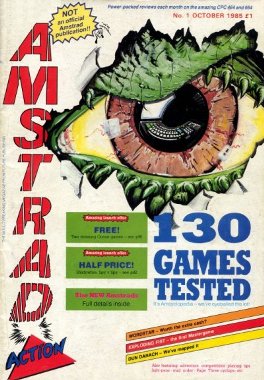
Amstrad Action was a monthly magazine, published in the United Kingdom, which catered to owners of home computers from the Amstrad CPC range and later the GX4000 console.

Your Sinclair, or YS as it was commonly abbreviated, was a commercially published and printed British computer magazine for the Sinclair range of computers, mainly the ZX Spectrum. It was in circulation between 1984 and 1993.

Sensible Soccer, often called Sensi, is an association football video game series which was popular in the early 1990s and which still retains a following. It was developed by Sensible Software and first released for Amiga and Atari ST computers in 1992 as well as for the IBM PC compatibles. The series was created by Jon Hare and Chris Yates, as a successor to their previous football game MicroProse Soccer (1988), which in turn was inspired by the arcade video game Tehkan World Cup (1985).
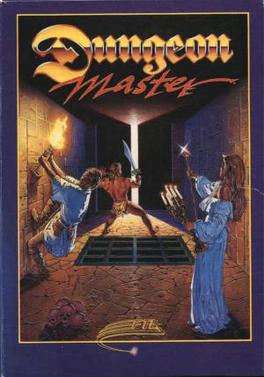
Dungeon Master is a role-playing video game featuring a pseudo-3D first-person perspective. It was developed and published by FTL Games for the Atari ST in 1987, almost identical Amiga and PC (DOS) ports following in 1988 and 1992.

Top Banana is an environmentally-themed platform game produced by Hex and Psycore for the Acorn Archimedes in 1991 and ported to the Amiga and Atari ST in 1992. The chief artist and coder was Miles Visman, with supporting graphics and sound by Karel Dander, and supporting graphics by Sophie Smith, Robert Pepperell and Matt Black. Top Banana was released using recycled cardboard packaging, furthermore being advertised as being the 'first video game with recycled packaging'. Top Banana's plot is about trying to save the environment from pollution using love.

Cannon Fodder is a series of war themed action games developed by Sensible Software, initially released as Cannon Fodder for the Commodore Amiga. Only two games in the series were created by Sensible, but were converted to most active systems at the time of release. A sequel, Cannon Fodder 2, was released in 1994 for Amiga and DOS. A third game, Cannon Fodder 3, was made by a Russian developer and released in English in 2012.
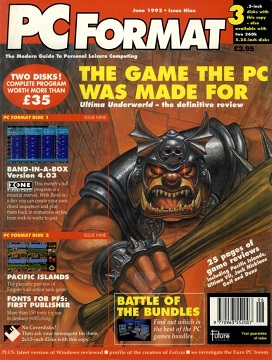
PC Format was a computer magazine published in the United Kingdom by Future plc, and licensed to other publishers in countries around the world. In publication between 1991 and 2015, it was part of Future plc's Format series of magazines that include articles about games, entertainment and how to get the most out of the platform. Despite the occasional mention of alternatives, PC Format takes the term 'PC' to mean a Microsoft Windows-based computer.

Zzap!64 was a computer games magazine covering games for computers manufactured by Commodore International, especially the Commodore 64 (C64). It was published in the UK by Newsfield Publications Ltd and later by Europress Impact.

Zero was a video game magazine in the UK, published monthly by Dennis Publishing Ltd. between November 1989 and October 1992. It won the InDin Magazine of the Year award in both 1990 and 1991, and was also briefly the best-selling multi-format 16-bit computer magazine in the UK.

Jungle Strike is a video game developed and published by Electronic Arts in 1993 for the Sega Genesis/Mega Drive. The game was later released on several other consoles such as the Super Nintendo Entertainment System (SNES), and an upgraded version was made for DOS computers. The Amiga conversion was the responsibility of Ocean Software while the SNES and PC DOS versions were that of Gremlin Interactive, and the portable console versions were of Black Pearl Software. It is the direct sequel to Desert Strike and is the second installment in the Strike series. The game is a helicopter-based shoot 'em up, mixing action and strategy. The plot concerns two villains intent on destroying Washington, D.C. The player must use the helicopter and occasionally other vehicles to thwart their plans.

Cannon Fodder 2: Once More unto the Breach, or simply Cannon Fodder 2, is an action-strategy shoot 'em up game developed by Sensible Software and published by Virgin Interactive for the Amiga and DOS in November 1994. The game is the sequel to Cannon Fodder, a successful game released for multiple formats in 1993. The game is a combination of action and strategy involving a small number of soldiers battling through a time-travel scenario. The protagonists are heavily outnumbered and easily killed. The player must rely on strategy and heavy secondary weapons to overcome enemies, their vehicles and installations.

PGA Tour Golf is a golf video game and the first in the PGA Tour game series. It was developed by Sterling Silver Software and released in 1990, for MS-DOS. It was initially published by Electronic Arts, which subsequently released versions of the game for Sega Genesis and Amiga in 1991, followed by a version for the SNES in 1992. By 1994, Tengen had published versions for Sega's Master System and Game Gear consoles. PGA Tour Golf received generally positive reviews for its realism, sound, and camera. Several critics considered the computer versions to be the best golf game available at the time of its release. It was followed by PGA Tour Golf II.

Sensible Train Spotting is a video game by Sensible Software for the Amiga computer. It is Sensible Software's last Amiga game and was available only on an Amiga Power cover disk from issue 53, dated September 1995. Because of this, it is not nearly as famous as some of Sensible Software's earlier releases, such as Sensible Soccer and Cannon Fodder.
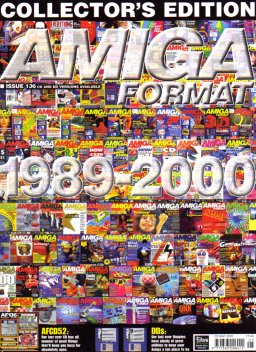
Amiga Format was a British computer magazine for Amiga computers, published by Future plc. The magazine lasted 136 issues from 1989 to 2000. The magazine was formed when, in the wake of selling ACE to EMAP, Future split the dual-format title ST/Amiga Format into two separate publications. In 1991, the magazine was selling 135,000 copies a month.

Mega was a British monthly magazine that covered the Mega Drive video game console. During its time as one of the main Mega Drive publications, Mega covered the "golden age" of the Sega Mega Drive from 1992 to 1995. The magazine went through many changes including a re-design in content and layout before being sold to a rival publisher.

Space Crusade is a 1992 video game based on the Space Crusade board game. It is the first video game set in the Warhammer 40,000 universe. Gremlin Graphics Software Ltd. released the video game version of Space Crusade in early 1992. It was available on Amiga, Atari ST, MS-DOS, Amstrad CPC, Commodore 64, and ZX Spectrum. It later received an expansion pack, The Voyage Beyond.
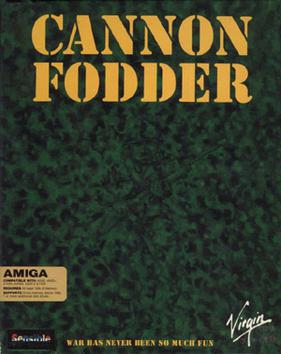
Cannon Fodder is a shoot 'em up developed by Sensible Software and published by Virgin Interactive Entertainment for the Amiga in 1993. Virgin ported the game to MS-DOS, the Atari ST and the Acorn Archimedes, as well as the Atari Jaguar, Mega Drive, SNES and 3DO. The game is military-themed and based on shooting action with squad-based tactics. The player directs troops through numerous missions, battling enemy infantry, vehicles and installations.

ATR: All Terrain Racing is a racing game published by Team17 for Amiga and Amiga CD32 on May 8, 1995. During a protracted dispute between Team17 and Amiga Power, the magazine's reviewer, Jonathan Nash, awarded ATR: All Terrain Racing a rating of 38%, prompting the developer to pursue a lawsuit for defamation.
Stuart Campbell is a Scottish blogger, video game designer and former video game journalist. Born in Stirling, he moved to Bath in 1991 to work for computer magazine Amiga Power as a staff writer, where he gained attention for his video game reviews. He has lived in Somerset ever since, and made further contributions to a number of publications both within the video game industry and in the popular media.

Read-Only Memory is a British publisher of art books on topics of video game history and culture. Following a resurgence of interest in 1980s and '90s British video game development, the company crowdfunded and produced four art books: an oral history of that Britsoft era, two books on British developers Sensible Software and The Bitmap Brothers, and a definitive volume on the Sega Mega Drive/Genesis, for which the publisher became best known. Read-Only Memory's books are archival anthologies, including original design documents juxtaposed with developer interviews and high-quality prints of in-game graphics. Reviewers were particularly impressed with each book's breadth of unreleased concepts.



















